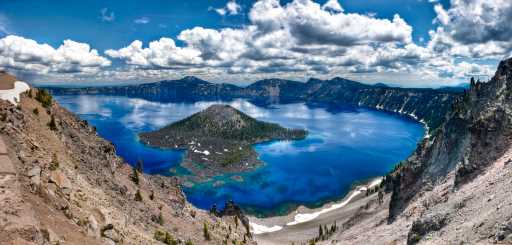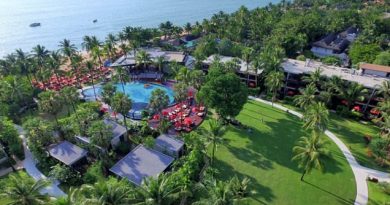Cascade Mountain High: Exploring Oregon’s Crater Lake National Park – The Denver Post
There’s a mysterious, otherworldly feel to Southern Oregon’s Crater Lake National Park. This gem-like lake, nestled high in the Cascade Range, is the deepest lake in North America — 1,943 feet — and is famous for its intensely blue waters.
It formed 7,700 years ago when Mount Mazama, a 12,000-foot-tall volcano, experienced the largest eruption in North America in the past 640,000 years and subsequently collapsed, forming a volcanic caldera, which then began to fill with rainfall and snowmelt.
There’s no natural outlet for Crater Lake’s water, yet it never completely fills up. The lake loses water, as it seeps out of the old volcano’s outer slopes at a slow but steady rate, like a porous paper coffee filter. It’s considered the cleanest large body of water in the world and holds a whopping 4.9 trillion gallons of water.
The park may be open year round for intrepid back country types, but those of us who prefer to circle the magnificent lake by car or bike — and hike snow-free trails — will want to aim for a summer or fall vacation, when the rim road is typically open. And now is the time to plan it.
We arrived at the park one evening last autumn after a short flight from SFO to Medford, Oregon, and a somewhat difficult 80-mile drive on the Volcanic Legacy Scenic Byway in the dark woods of the western Cascade Range. Cell service is spotty here, so it’s best to set your GPS to “Crater Lake Dining” before leaving civilization and keep a keen eye out for deer on the road, especially at night.
We made it to the park just in time for our 8:30 dinner reservation at the charming, historic Crater Lake Lodge, the only place to overnight and dine during the fall shoulder season. The park offers camping and cabins at Mazama Village, seven miles from the lake, but for a premier lodging experience nothing beats this one. Perched right on the caldera’s rim, Crater Lake Lodge has been a favorite spot to overnight in the park since 1915.
The inn’s sitting and dining rooms are charming, but the meals (as in many National Park lodges) can be a bit disappointing — and expensive. Next time, we may bring our own food (in a cooler to bring into the room as hungry bears have been known to break into cars) and a few bottles of wine to enjoy on the lodge’s scenic deck, equipped with vintage rocking chairs from which to enjoy the outstanding lake views.
Early the next day, we grabbed to-go breakfasts at the Rim Village Store and headed out on the park’s 33-mile-long Rim Road for a clockwise exploration, stopping to hike, picnic and photograph the many sights of this majestic place. The park has plenty of room to explore — almost 200,000 acres — and attracts road trippers, day hikers, backpackers and cyclists in summer and, in winter, snowshoers and cross-country skiers.
The main focus for most summer-fall visitors are day hikes from the park’s many trailheads and overlooks. It’s also a paradise for nature and landscape photographers and for astrophotographers seeking that perfect shot of the Milky Way, thanks to the park’s unpolluted skies on cloudless, moonless nights.
Heading out from the Rim Village, we drove first to Discovery Point, a pullout, for an overview of the lake’s southwest shore. Cone-shaped Wizard Island sits close to shore, and the waters of the lake appeared mirror-like in the morning calm. Soon the sun crested the peaks and ranges surrounding the lake, forming a golden crown. This is the spot where, in 1853, gold prospector John Hillman accidentally “discovered” the lake (it was actually well known and considered sacred by the indigenous tribes who lived here for thousands of years).
A short distance up the road is the Watchman Peak Overlook and the trailhead to a fire lookout that’s a favorite spot for sunrise and sunset-seekers and hiking access to stunning panoramic views from the top of Watchman Peak (8,013 feet). The 1.6-mile roundtrip trail takes about an hour to complete and gains some 420 feet in elevation on the way up.
If you want to get a lakeside view of Crater Lake’s famous waters, the Cleetwood Cove Trail is a must. This short (1.1 mile) but steep trail provides the only foot access from the rim to the lakeshore. Key piece of information: You drop 700 feet in elevation on the way down (equivalent to 65 flights of stairs) and, of course, have to walk back up after you enjoy the lake’s clear, cold water. Swimming (no wetsuits) and fishing (artificial lures or flies only) are popular activities at the cove. Crater Lake is home to rainbow trout and Kokanee salmon, and fishing is allowed (catch-and-release or to keep, no fishing license required).
Avid hikers can take on the 4.4-mile roundtrip hike to the summit of Mount Scott, a gradual ascent that provides great panoramic views. Mount Scott is the park’s highest peak at 8,929 feet in elevation. If you want a taste of hiking the famed Pacific Crest Trail (PCT), there are two trailheads within the park where the PCT crosses the park. Several thousand backpackers pass through Crater Lake National Park each year, as they tackle the rugged route that stretches from Canada to Mexico.
All of the 30 overlooks along the Rim Road are worth a stop, and we particularly enjoyed the Cloudcap Overlook at the end of a 1-mile spur road — the highest paved road in Oregon — and the Phantom Ship Overlook, where views of a small rocky island resemble a ghost ship at sea. The island is composed of erosion-resistant lava estimated to be 400,000 years old. Also on East Rim Drive: pretty Vidae Falls, which tumbles over a glacier-carved cliff, dropping 1,000 feet over a series of ledges. In summer, wildflowers abound here.
If you’re not much a hiker, a great way to see Crater Lake is by trolley. The ranger-narrated tours depart from the Rim Village daily every hour from 10 a.m. to 3 p.m. from July through September and last about two hours. The trolley explores the west and north section of Rim Drive, one of America’s most scenic roads. The trolley stops at five to 10 scenic overlooks, where you can get off and enjoy the views without breaking a sweat.
If You Go
Crater Lake National Park: A 7-day entrance pass is $30 per car, payable by debit or credit card or Apple or Samsung pay (no cash accepted). Find maps, hiking trail information and other details at www.nps.gov/crla/.
Crater Lake Lodge: The historic lodge offers just 71 rooms, so be sure to book as far ahead as possible. For the 2023 season, which runs May 12 to Oct. 15, rooms ($212 and up) were still available for dates in May and October as of press time; www.travelcraterlake.com.
Crater Lake Trolley: Tours ($25-$36) depart from the Rim Village near Crater Lake lodge daily beginning July 1. Reservations are recommended; www.craterlaketrolley.net.
Ride the Rim: This popular family-oriented biking event takes place on Sept. 9 and 16, when the park will close most of the perimeter road, allowing bicyclists to gather for an organized mass ride around the rim of the crater. The event is free, but advance registration and the park entrance fee are required; www.ridetherimoregon.com.
Source: Read Full Article






